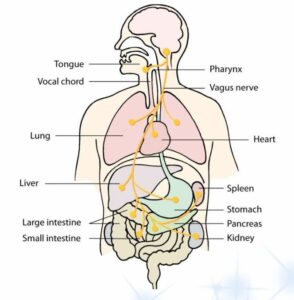We all have a vagus nerve that runs throughout our body from our brain to our gut. It is one nerve but it is so powerful when it comes to how we feel in our bodies and how our body works to regulate our nervous system.
When I use the word anxiety, not as a diagnosis, but as a description for our nervous system being activated, it means there is some dysregulation happening internally. How can we move towards regulation when feeling dysregulated? Well, there are many ways, and most either directly or indirectly target the vagus nerve because when this is toned, our body’s work is more regulated and/or can return to regulation quicker.
The function of the vagus nerve is to stimulate smooth muscle contractions and glandular secretions in the affected organs. The nerve does carry its own tone and that tone influences the strength in which it delivers signals to the muscles.
Why is this important?
Because our vagus nerve turns on and off our body’s stress response system (fight/flight/freeze/fawn) so if our body is experiencing anxiety more often than is comfortable, toning this nerve will have a direct effect on your nervous system in a positive way. You will gradually begin feeling better as your stress response is not overtaking your body as you are actively working to interrupt that stress response loop.
So how can we tone our vagus nerve?
Adults:
- Breathing: deep and slow, purposeful, diaphragmatic breathing (focus on longer exhales, ie: min 4s exhale, box breathing)
- Vocal cord stimulation: singing, humming, chanting, gargling
- Cold exposure: cold showers, ice cubes melting in hands, cold water on face/hands
- Exercising: specifically weight lifting, HIIT, cardio (incl. walking)
- Positive social interactions and laughing
Children:
- Co-Regulation: our children’s vagal tone is influenced by their parents vagal tone – working on our own vagal tone will naturally support our children’s vagal tone
- Water play: specifically pouring of water, calm baths, floating in a pool
- Sand play: simple play with kinetic sand, letting it fall through the fingers, squishing it, etc. (keep it contained in a bucket to minimize mess if that’s a concern)
- Positive social interactions: being with caregivers (incl. teachers, grandparents, friends) who interactive in a primarily positive way most of the time
- Outdoors: fresh air, non-directive play or time outside all throughout the year
Our RSW Laura Archer also is certifying in a play therapy modality, Theraplay, that specifically targets co-regulation through polyvagal theoretical practices based in attachment science. To find out more or to book an appointment, call or email our clinic.
By: Laura Archer, MSW, RSW

